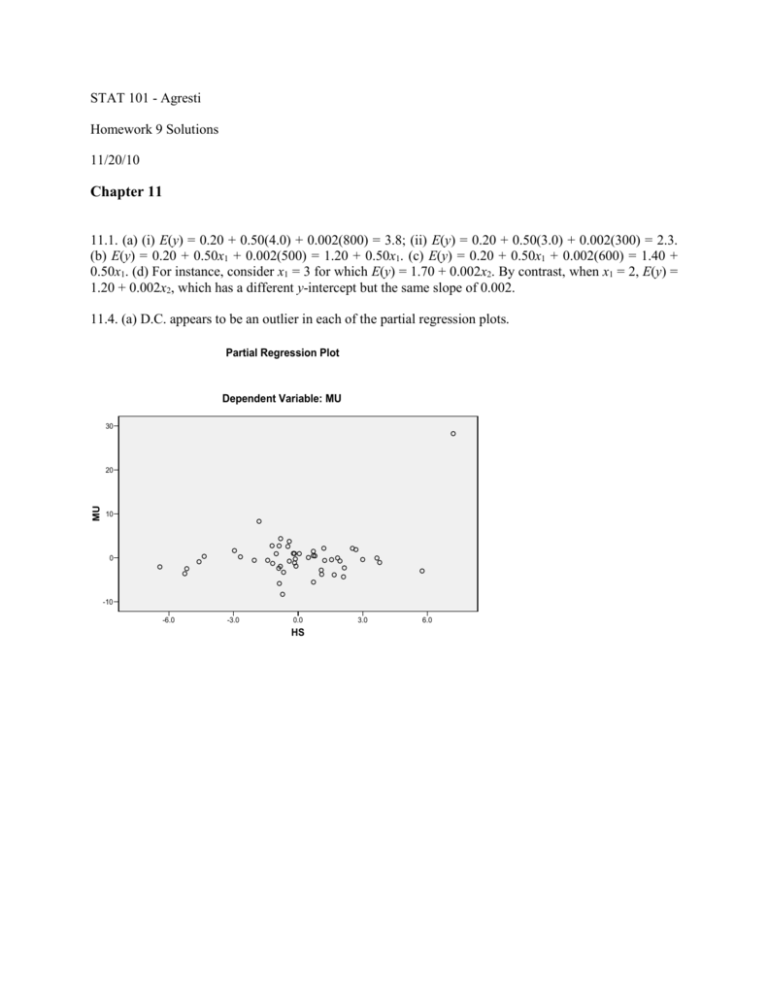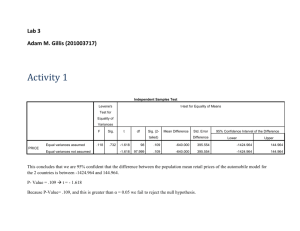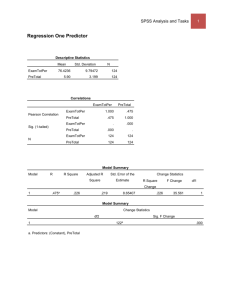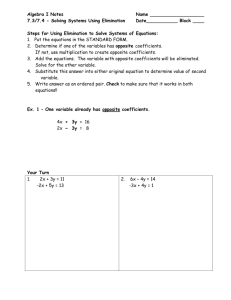Homework 9
advertisement

STAT 101 - Agresti Homework 9 Solutions 11/20/10 Chapter 11 11.1. (a) (i) E(y) = 0.20 + 0.50(4.0) + 0.002(800) = 3.8; (ii) E(y) = 0.20 + 0.50(3.0) + 0.002(300) = 2.3. (b) E(y) = 0.20 + 0.50x1 + 0.002(500) = 1.20 + 0.50x1. (c) E(y) = 0.20 + 0.50x1 + 0.002(600) = 1.40 + 0.50x1. (d) For instance, consider x1 = 3 for which E(y) = 1.70 + 0.002x2. By contrast, when x1 = 2, E(y) = 1.20 + 0.002x2, which has a different y-intercept but the same slope of 0.002. 11.4. (a) D.C. appears to be an outlier in each of the partial regression plots. Partial Regression Plot Dependent Variable: MU 30 MU 20 10 0 -10 -6.0 -3.0 0.0 HS 3.0 6.0 Partial Regression Plot Dependent Variable: MU 40 30 MU 20 10 0 -10 -4.0 -2.0 0.0 2.0 4.0 6.0 8.0 10.0 PO (b) ŷ = –60.498 + 0.588x1 + 1.605x2. For fixed poverty rate, the murder rate is predicted to increase by 0.588 for each additional percent increase of high school graduates. For fixed percentage of graduates, the murder rate is predicted to increase by 1.65 for each additional percent increase in the poverty rate. Model Summary(b) Model 1 R 0.636(a) R Square 0.405 Adjusted R Square 0.380 Std. Error of the Estimate 4.764 a Predictors: (Constant), PO, HS b Dependent Variable: MU Coefficients(a) Unstandardized Standardized Coefficients Coefficients Model 1 B -60.498 Std. Error 24.615 HS 0.588 0.260 PO 1.605 0.301 (Constant) Beta t Sig. B -2.458 Std. Error 0.018 0.351 2.256 0.029 0.830 5.332 0.000 a Dependent Variable: MU (c) With D.C. removed, the predicted effect of poverty rate is reduced from 1.605 to 0.304, less than a fifth as large. In addition, note that the estimated effect of percent of high school graduates now has a negative partial coefficient rather than a positive one. So, outliers can be highly influential in a regression analysis. Model Summary(b) Model 1 R 0.582(a) R Square 0.338 Adjusted R Square 0.310 Std. Error of the Estimate 2.136 a Predictors: (Constant), PO_noDC, HS_noDC b Dependent Variable: MU_noDC Coefficients(a) Unstandardized Coefficients Model 1 (Constant) B 18.912 Std. Error 12.437 HS_noDC -0.196 0.130 0.304 a Dependent Variable: MU_noDC 0.164 PO_noDC Standardized Coefficients Beta t Sig. B 1.521 Std. Error 0.135 -0.278 -1.510 0.138 0.340 1.846 0.071 11.5. (a) ŷ = –3.601 + 1.2799x1 + 0.1021x2. (b) ŷ = –3.601 + 1.2799(10) + 0.1021(50) = 14.3. (c) (i) ŷ = –3.601 + 1.2799x1 + 0.1021(0) = –3.601 + 1.2799x1; (ii) ŷ = –3.601 + 1.2799x1 + 0.1021(100) = 6.609 + 1.2799x1; On average, for each increase of $1000 in GDP, the percentage of people who use the Internet increases by 1.28. (d) Since the slope for GDP is the same for each of the two models in part (c), the lines are parallel, and there is no interaction between cell-phone use and GDP in their effects on the response variable. 11.6. (a) R-squared = (TSS – TSE)/TSS = (12,959.3 – 2642.5)/12,959.3 = 10,316.8/12,959.3 = 0.796. There is about 80% less error when we predict cell-phone use with the prediction equation with these two predictors than when we predict it using the sample mean. (b) Since cell-phone use and GDP are strongly positively correlated, adding cell-phone use to the model will not improve the model much beyond only using GDP as a predictor of Internet use. 11.7. (a) Positive, since crime appears to increase as income increases. (b) Negative, since controlling for percent urban, the trend appears to be negative. (c) ŷ = –11.5 + 2.6x1; the predicted crime rate increases by 2.6 (per 1000 residents) for every $1000 increase in median income. (d) ŷ = 40.3 – 0.81x1 + 0.65x2; the predicted crime rate decreases by 0.8 (per 1000 residents) for each $1000 increase in median income, controlling for level of urbanization. Compared to (c), the effect is weaker and has a different direction. (e) Urbanization is highly positively correlated both with income and with crime rate. This makes the overall bivariate association between income and crime rate more positive than the partial association. Counties with high levels of urbanization tend to have high median incomes and high crime rates, whereas counties with low levels of urbanization tend to have low median incomes and low crime rates, and these effects induce the overall positive bivariate association between crime rate and income. (f) (i) ŷ = 40.3 – 0.81x1; (ii) ŷ = 73 – 0.81x1; (iii) ŷ = 105 – 0.81x1. The slope stays constant, but at a fixed level of x1, the crime rates are higher at higher levels of x2. 11.19. (a) The scatterplots are: 600,000 500,000 Price 400,000 300,000 200,000 100,000 0 1,000 2,000 3,000 4,000 Size 600,000 500,000 Price 400,000 300,000 200,000 100,000 0 2 2 3 4 4 4 5 Beds 600,000 500,000 Price 400,000 300,000 200,000 100,000 0 1 2 2 2 3 4 4 Baths There is a moderately strong positive linear relationship between the selling price of a home and its size (in square feet). In the scatterplots of selling price versus either number of bedrooms or number of bathrooms, we see stacking at the integer values for the predictors, which are highly discrete. (b) ŷ = –27,290 + 130x1 – 14,466x2 + 6890x3; $130 = change in predicted selling price of a home for 1 square foot increase in size, controlling for number of bedrooms and number of bathrooms. Coefficients(a) Standardized Unstandardized Coefficients Coefficients Model 1 Sig. B -0.966 Std. Error 0.336 B -27290.075 Std. Error 28240.514 130.434 11.951 0.859 10.914 0.000 -14465.770 10583.489 -0.093 -1.367 0.175 6890.267 a Dependent Variable: Price 13539.977 0.039 0.509 0.612 (Constant) Size Beds Baths Beta t (c) (i) The size of the house has the strongest correlation with the selling price of the house. (ii) The number of bedrooms has the weakest correlation with the selling price of the house. Correlations Price Price Pearson Correlation 1 Size 0.834(**) Beds 0.394(**) Baths 0.558(**) 0.000 Sig. (2-tailed) N Size Pearson Correlation Sig. (2-tailed) N Beds Pearson Correlation Sig. (2-tailed) N Baths Pearson Correlation Sig. (2-tailed) N 0.000 0.000 100 100 100 100 0.834(**) 1 0.545(**) 0.658(**) 0.000 0.000 0.000 100 100 100 100 0.394(**) 0.545(**) 1 0.492(**) 0.000 0.000 100 100 100 100 0.558(**) 0.658(**) 0.492(**) 1 0.000 0.000 0.000 100 100 100 0.000 100 ** Correlation is significant at the 0.01 level (2-tailed). (d) R2 = 0.701 for the full model; r2 = 0.695 for the simpler model using x1 alone as the predictor. Once x1 is in the model, x2 and x3 do not add much more information for predicting selling price. 11.25. (a) (i) –0.612, (ii) –0.819, (iii) 0.757, (iv) 2411.4, (v) 585.4, (vi) 29.27, (vii) 5.41, (viii) 10.47, (ix) 0.064, (x) –2.676, (xi) 0.0145, (xii) 0.007, (xiii) 31.19, (xiv) 0.0001. (b) ŷ = 61.71 –0.171x1 – 0.404x2; 61.71 = predicted birth rate at ECON = 0 and LITERACY = 0 (may not be useful), –0.171 = change in predicted birth rate for 1 unit change in ECON, controlling for LITERACY, –0.404 = change in predicted birth rate for 1 unit change in LITERACY, controlling for ECON. (c) –0.612; there is a moderate negative association between birth rate and ECON; –0.819; there is a strong negative association between birth rate and LITERACY. (d) R2 = (2411.4 – 585.4)/2411.4 = 0.76; there is a 76% reduction in error in using these two variables (instead of y ) to predict birth rate. (e) R 0.76 0.87 = the correlation between observed y values and the predicted y values, which is quite strong. (f) F = [0.757/2]/[(1 – 0.757)/20] = 31.2, df1 = 2, df2 = 20, P = 0.0001; at least one of ECON and LITERACY has a significant effect. (g) t = –0.171/0.064 = –2.676, df = 20, P = 0.0145; there is strong evidence of a relationship between birth rate and ECON, controlling for LITERACY. 11.44. Since there is essentially no effect for political conservatives and a considerably positive effect for political liberals, there is an interaction between number of years of education and political ideology. One would add an interaction term to the multiple regression model to allow the partial slope to be positive for liberals and close to 0 for conservatives. One of the predictors would be political ideology, for example on the scale of 1 to 7 that the GSS uses, ranging from very conservative to very liberal. 11.46. False. We could make this conclusion if these were standardized coefficients, but not as unstandardized coefficients. We cannot compare the sizes of partial slopes when the different predictor variables have different units of measurement. 11.48. (a) R cannot be smaller than the absolute value of any of the bivariate correlations. (b) SSE cannot increase when we add predictors, (h) R2 cannot exceed 1. (i) This is the multiple correlation, which cannot be negative. (j) No, this is only true when df1 = 1, in which case F = t2. (k) We need to compare the absolute values of standardized coefficients to determine which explanatory variable has a stronger effect. We cannot compare the sizes of partial slopes when the different predictor variables have different units of measurement. (n) The product takes value over a very wide range, and a 1-unit change in the product is a trivial amount, so this coefficient is then small even if the effect is strong in practical terms. 11.49. (b), since (20 – 10)3 = 30. 11.66. (a) yˆ 26.1 72.6 x1 19.6 x2 ; Older homes: yˆ 26.1 72.6 x1 ; new homes: yˆ 6.5 72.6 x1 . (b) When x2 = 1, the y-intercept is 19.6 higher than when x2 = 0. This is the difference of estimated mean selling prices between new and older homes, controlling for house size. 11.67. (a) Older homes: yˆ 16.6 66.6 x1 ; New homes: yˆ 15.2 96 x1 . New homes cost more, on average, than older homes, for each fixed value of size. In addition, the selling price for a new home increases at a higher rate as the size increases than does the selling price for an older home. (b) Older homes: yˆ 16.6 66.6 x1 ; New homes: yˆ 7.6 71.6 x1 . With the outlier removed, there is not as much difference in selling price between new and older homes, and, as the size increases, the selling price for a new home increases at a much slower rate than the model with the outlier. The outlier results in rather misleading conclusions about the difference between new and old homes in the effect of size.









